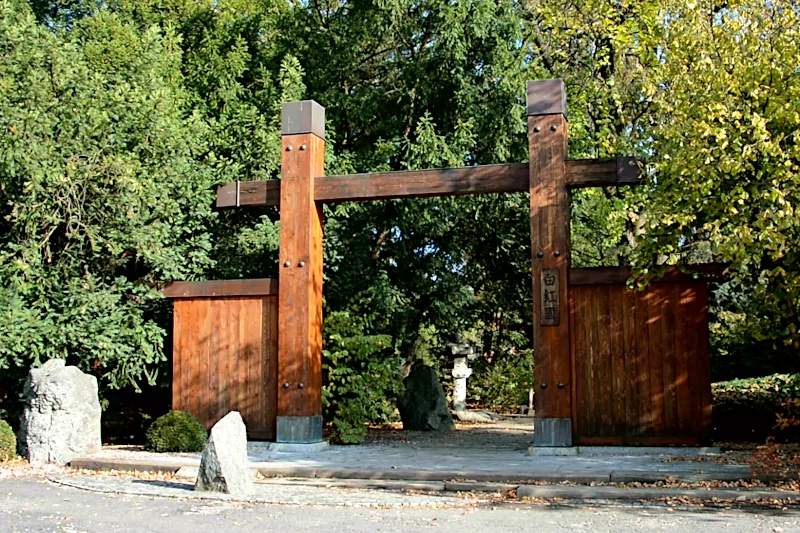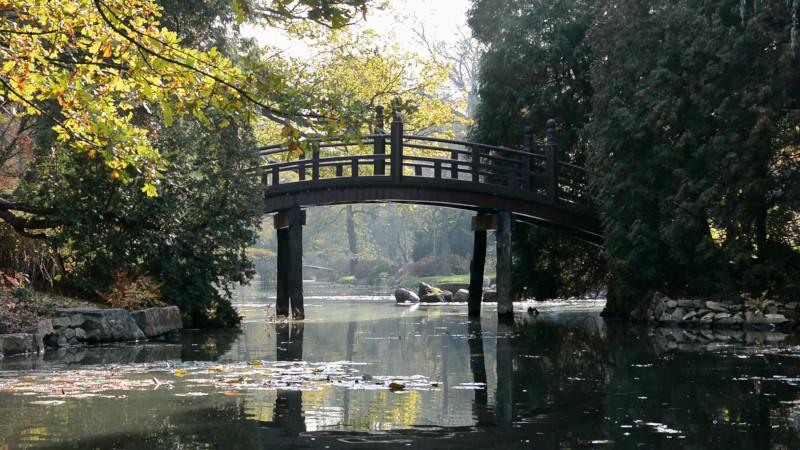
For visitors to Wroclaw (formerly german Breslau), who are not just hunting through the old city center, a short excursion to the eastern districts is worthwhile. In addition to the zoo with its Afrikarium and the Century Hall, the lovingly designed Japanese Garden is definitely worth a visit.
Festival Grounds for the Anniversary of the Wars of Liberation in 1913 – Century Hall and Japanese Garden
The Japanese Garden in Wroclaw is part of the Szczytnicki Park, which stretches north of the Hala Stulecia – the Hall of Centuries. Large festivities were planned in 1913 to celebrate the one hundredth anniversary of the wars of liberation against Napoleon. In Wroclaw, which was German Breslau at the time, the huge Hall of the Century was built. The surrounding area was also redesigned as a festival ground. The Imperial Count Friedrich Maximilian von Hochberg auf Halbau introduced the idea for a Japanese-style garden. The garden was created from 1909 to 1912 north of the Century Hall. Among others, the Japanese gardener Arai Mankichi was involved in this. There was even a heating house to warm part of the ponds for heat-loving Japanese water plants.
Re-establishment of the garden facilities in the mid-90s
After the 1913 celebrations, most of the garden furnishings were dismantled again and loans from Japan were returned. Only the basic structure of the paths and water areas remained for the city of Breslau.
In the mid-1990s, the now Polish city of Wroclaw recalled the old plans. A team of garden experts from Poland and the Japanese city of Nagoya reworked and expanded the grounds of the 1913 Japanese garden.
However, the joy after the reopening in 1997 lasted only a few months. A flood on the Oder River destroyed large parts of the garden that had just been inaugurated in the same year. By the turn of the millennium, the Japanese Garden of Wroclaw was renewed. In reference to the national colors of Poland and Japan, the garden is called Japanese Hakkoen, “white-red – garden”. A variety of design elements typical of Japanese gardens offer the eye in the garden of Wroclaw always new surprising views.
A garden idyll in the Far Eastern style
The garden is entered through a large Sukiya Mon gate. Then the visitor walks along sandy paths between old oaks, maples, rhododendrons, azaleas and partly exotic trees and shrubs such as golden larch, ginkgo and cord trees. The large lake is a first eye-catcher. This is spanned by a wooden footbridge, with a covered pavilion Yumedono Bashi in the center. Watercourses cross the path. Since the reconstruction of the Japanese Garden, there is now a “male” and a “female” waterfall (Otoko Daki and Onna Daki). Characteristically, the male fall plunges hard and steeply over a stone barrier, while the female waterfall winds in gentle rapids between bed sills.

Near Onna Daki you can walk along the lake shore over stepping stones. Both on the island and in the wider area there are pruned woods, traditional lanterns (Taiko toro), a stone pagoda (Sanju-no-to), over the watercourse the drum bridge (Taiko bashi). On the southern edge of the Japanese garden is the tea place with the Azumaya tea house. You can leave the garden through the side gate Fuku Mon.
Visit recommendations for the Japanese Garden Wroclaw
For the visit to the Japanese Garden Wroclaw an entrance fee (ca.20 PLZ) is charged. This is definitely reasonable considering the well-kept and stylish grounds. The Japanese Garden Wroclaw is open from spring to autumn (March to October). I was there at the end of October. Of course, there were hardly any flowering plants at this time of year, but gorgeous golden autumn foliage and sunlight muted by a fine streak of mist over the waterways – a truly meditative mood. You should definitely take some time for the Japanese garden and enjoy the tranquility of the grounds. You can also sit on benches in the sun, look out over the small lake and daydream away.
However, I recommend headphones and meditative music in your ogg player when visiting! Because behind the Japanese garden in Wroclaw runs the unfortunately quite strongly driven Adam Mickiewicz – street, so that the traffic noise acoustically impairs the contemplative basic mood. Sound protection and Zen – music like in the video clearly upgrade the visit in the Japanese garden Wroclaw.
Adama Mickiewicza 1
51-618 Wrocław
